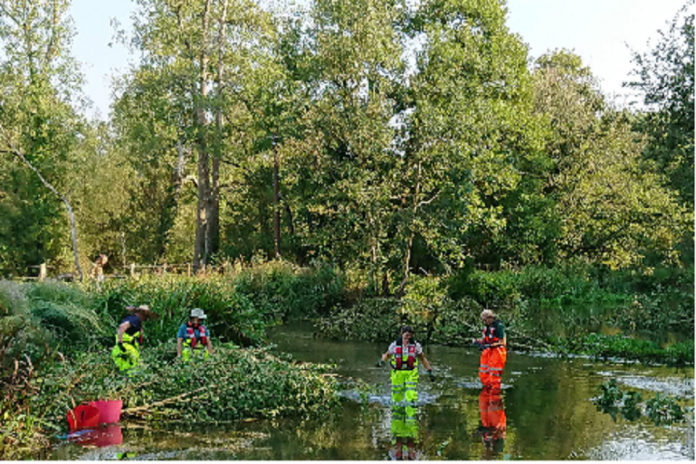The project, which was partly funded by the MOD and designed by WWT’s Water Team in consultation with the MOD and SDFFA, continues work undertaken by WWT in the area in 2016 to improve the condition of the River Avon Site of Special Scientific Interest (SSSI).
The restoration work, which was completed last month by a team of Defence Infrastructure Organisation (DIO) environmental specialists and WWT staff, took place at tank crossing Charlie which is located on the River Avon just north of Durrington near the village of Milston. The work involved installing permeable wooden structures within the river at several points to narrow the channel and speed up the flow of the river. This will reduce silt deposition and create areas of exposed gravel for fish to spawn.
Volunteers and staff using willow to build a woody habitat berm on the River Avon. Copyright WWT 2020.
Oliver Howells, DIO’s Senior Ecologist, said:
The MOD has over 80,000 SSSI and it has a responsibility to manage these sites to maintain them in what is called Favourable condition. This project is a great example of how we have worked with one of our key partners to achieve that.
The WWT Water Team are highly skilled and well equipped to carry out this work. Thanks to their ongoing hard work, and the contribution from a team of DIO volunteers, we have been able to improve this stretch of the river, which is widely known as one of the best chalk streams in the UK. It was also a fantastic opportunity for some of DIO’s environmental specialists to get their hands dirty and better understand the ecology of the river and the pressures affecting it.
In total 6 large wooden structures were installed into the channel. The wood was sourced on site by coppicing and pollarding trees along the bank and cutting back overhanging vegetation. This has the additional benefit of allowing more light to get down to the river and improving access for anglers.
Alice Baker, WWT’s Water Team Manager said:
This project contributes to over 20 years of ongoing work by WWT to restore and protect the River Avon. Thanks to the support of the MOD we were able to enhance this 400m stretch of river, connecting previously restored reaches upstream and downstream of the crossing.
A huge thank you to the DIO volunteers for their hard work; the woody structures we built will add to the flow and habitat diversity of the river, providing marginal habitat for species such as water vole and kingfisher and cover for small and juvenile fish.







